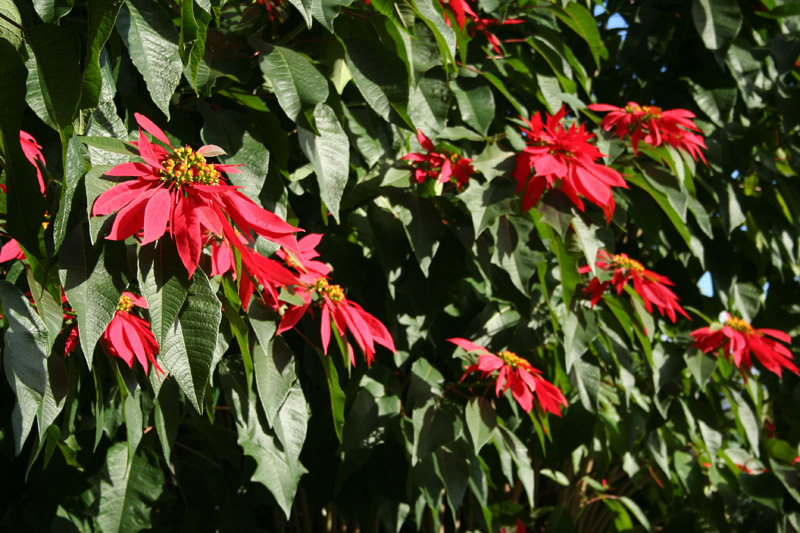The poinsettia (/p??n's?ti?/ or /p??n's?t?/) (Euphorbia pulcherrima) is a commercially important herb types of the diverse spurge family. The species is indigenous to Mexico. It is particularly well known for its red and green foliage and it is widely used in Xmas floral exhibits. It derives its common English name from Joel Roberts Poinsett,[3] the first United States Minister to Mexico,[4] who introduced the plant to the US in 1825.
Euphorbia pulcherrima is a shrub or small tree, typically achieving a level of 0.6-4 metres (2 ft 0 in-13 ft 1 in). The place bears dark inexperienced dentate leaves that measure 7-16 centimetres (2.8-6.3 in) long. The colored bracts--which are most flaming red but can be orange often, pale green, cream, pink, white, or marbled--are often mistaken for blossom petals for their groupings and colors, but are actually leaves.[citation needed] The colors of the bracts are manufactured through photoperiodism, and therefore they might need darkness (12 hours at a time for at least five days in a row) to change color. At the same time, the crops require abundant light during the day for the brightest color. The flowers of the poinsettia are unassuming , nor attract pollinators. They are really grouped within small yellowish structures within the center of each leaf bunch, and are called cyathia. The poinsettia is indigenous to Mexico. It is found in the untamed in deciduous exotic forests at average elevations from southern Sinaloa down the whole Pacific coast of Mexico to Chiapas and Guatemala. It is found in the interior in the hot also, dried up forests of Guerrero seasonally, Oaxaca, and Chiapas. Information of E. pulcherrima growing in the wild in Nicaragua and Costa Rica have yet to be confirmed by botanists. You will find over 100 cultivated types of poinsettia.
The Aztecs used the plant to produce red dye and as an antipyretic medication. In Nahuatl, the language of the Aztecs, the plant is named Cuitlaxochitl, meaning "flower that grows in residues or soil" Today it is well known in Mexico and Guatemala as Flor de Noche Buena, meaning Christmas Eve Flower. In Spain it is recognized as Flor de Pascua or Pascua, signifying Easter flower. In Chile and Peru, the plant became known as Crown of the Andes. In Turkey, it is named Atat?rk's blossom because Atat?rk, the creator of the Republic, liked this rose and made a substantial contribution to its cultivation in Turkey.[citation needed] In Hungarian, it is named Santa Claus' Bloom, and it's widely used as a Holiday decoration.
The plant's connection with Christmas started out in 16th-century Mexico, where legend tells of a girl, called Pepita or Maria commonly, who was too poor to provide a gift for the celebration of Jesus' birthday and was influenced by an angel to assemble weeds from the roadside and place them before the church altar. Crimson blossoms sprouted from the weeds and became beautiful poinsettias. From the 17th century, Franciscan friars in Mexico included the plants in their Christmas celebrations. The star-shaped leaf structure is thought to symbolize the Celebrity of Bethlehem, and the red colorization represents the bloodstream sacrifice through the crucifixion of Jesus. Poinsettias are popular Holiday designs in homes, churches, offices, and across North America in other places. They are available in good sized quantities from grocery, drug, and hardware stores. In america, Dec 12 is National Poinsettia Day.
The Garden Worm blog Digging up the best dirt on gardening!
Santa Barbara Garden Design Poinsettias Don’t Have to Get Tossed
Poinsettia hedge

Poinsettias are used regularly in the landscape in Ecuador


Tidak ada komentar:
Posting Komentar